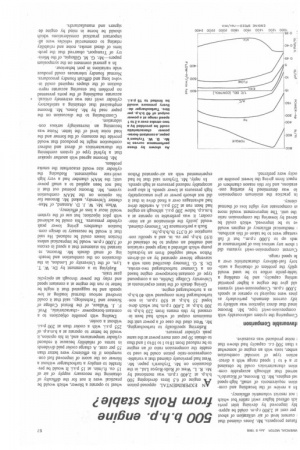500 b.h.p. engine from Rolls stable?
Page 59

If you've noticed an error in this article please click here to report it so we can fix it.
Al EXPERIMENTAL opposed-piston engine of 6.5 litres developing 500 b.h.p. at 2,400 r.p.m. was mentioned by Mr. R. L. West of Rolls-Royce Ltd., in the discussion on Mr. Tryhorn's paper. Mr. West had previously claimed that a variablecompression-ratio piston could be used to enable the compression ratio of an engine to be reduced from 18 to 1 to 10 to 1 and thus to obtain 50 per cent more power at the same peak cylinder pressure.
Referring specifically to turbocharging, Mr. West cited the case of a power unit the maximum output of which had been increased by this means from 220 b.h.p. to 300 b.h.p. at 2,400 r.p.m. but which developed 55 b.h.p. at 650 r.p.m. in nonturbocharged form compared with 40 b.h.p. as a turbocharged engine.
Giving details of the latest experiments at University College Dublin, on a compound type of constant-horsepower engine based on a Commer turbocharged two-stroke, Dr. S. G. Timoney described tests with a scavenge blower operated by an oil-driven Pelton wheel supplied from an hydraulic pump which afforded a large speed variation and enabled an output to be obtained of 0.93 b.h.p. per cu. in. and a specific consumption of 0.375 lb./b.h.p./hr.
Such a performance Dr. Timoney claimed, would justify the elimination of an intercooler; it was preferable to operate at a b.m.e.p. below 200 p.s.i. although an engine had been run at 255 p.s.i. A variable drive had advantages over a fixed drive in that it did not absorb power or give unacceptably high pressures at lower speeds. It also gave acceptably reduced pressures at high speeds.
In reply. Mr. Tryhorn said that he had experimented with an air-operated Pelton wheel to operate a blower, which would be practical were it not for the difficulty of obtaining the necessary supply of air of 15 cu. ft./min. at 15 p.s.i. It would be preferable to employ a turbocharger without a blower on the score of improved fuel con sumption if its efficiency were better than 55 per cent. A charge cooler paid dividends in terms of reliability because it reduced cylinder temperatures and, in his opinion, it would be better to operate at a b.m.e.p. of 255 p.s.i. with a cooler than at 200 p.s.i. without a cooler.
Dealing with possible objections to a constant-horsepower • characteristic, Prof.
F. J. Wallace, of the Bristol College of Science and Technology, said that it could involved serious thermal loading at low speeds and he suggested that it might be better to run the engine at a constant speed and relay the power through an epicyclic gear train.
Replying to a comment by Dr. W. T. Lyn, of the University of London, in the discussion on the combustion and breathing of small diesels Mr. Broome. re iterated his statement that a speed in excess of 5,000 r.p.m. would be impractical unless friction losses could be reduced. He said that it would be necessary to design combustion chambers giving lower peak cylinder pressures. This could be achieved with pilot injection; but use of the system would incur a loss of efficiency.
When Mr. W. J. D. Annand, of Manchester University, asked Mr. Broome for his opinion on the MAN combustion system, Mr. Broome pointed out that it had not been applied to a small power unit; the MAN chamber had a very high swirl-rate requirement. Reducing the cylinder size would exacerbate the smoke problem.
Mr. Broome agreed with another speaker that a hybrid type of system combining the characteristics of direct and indirect combustion might be produced that would provide the economy of the former and the load noise level of the latter. Noise was becoming an increasingly serious consideration.
Contributing to the discussion on the paper read by Mr. Jones, Mr. Broome emphasized that obtaining a satisfactory cylinder swirl rate was extremely critical: • accurate machining of the ports presented no problem but ensuring accurate repro duction of the shapes required could involve long and difficult foundry procedures. Normal foundry tolerances could produce wide variations in port behaviour.
In a general comment on the symposium papers—Mr. G. M. Gillespie, of the Minis try of Transport, observed that the prob lems of diesel smoke, noise and reliability relating to commercial vehicles were all important practical considerations which should be borne in mind by engine designers and manufacturers.




























































































































